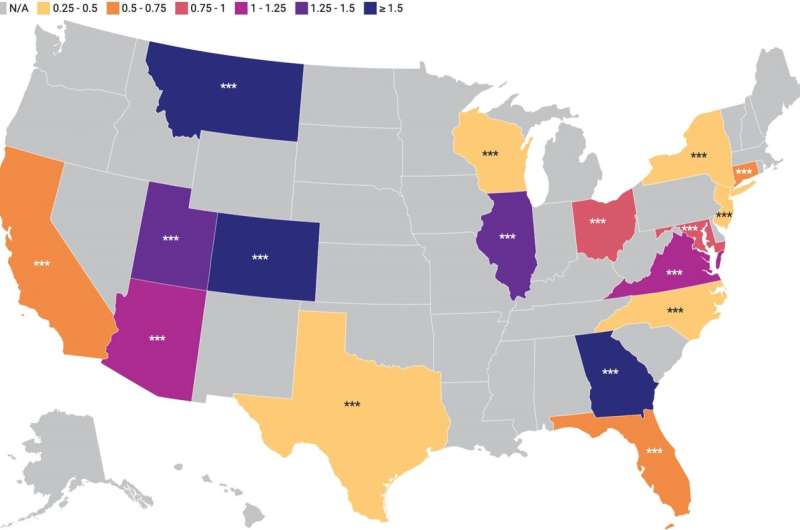This article has been reviewed according to Science X's editorial process and policies. Editors have highlighted the following attributes while ensuring the content's credibility:
fact-checked
peer-reviewed publication
trusted source
proofread
Children with Medicaid less likely to receive helmet therapy for a flattened head

When indicated, helmet therapy is a highly effective treatment for position-related head flattening (deformational plagiocephaly [DP]) in infants. However, infants with Medicaid insurance are less likely to receive helmet therapy and more likely to have delayed treatment, reports the July issue of Plastic and Reconstructive Surgery.
"Our study also shows wide variation in access to helmet therapy for DP between states, related to state-level variations in Medicaid policy related to this common head shape deformity," comments ASPS Member Surgeon Michael Alperovich, MD, MSc, of Yale University School of Medicine. The paper appears as part of an expanded pediatric/craniofacial surgery section, commemorating July as National Cleft and Craniofacial Awareness and Prevention Month.
Insurance status affects care for infants with deformational plagiocephaly
Deformational plagiocephaly refers to flattening of the skull due to continuous external pressure on one side or area. It often occurs when the baby sleeps consistently in the same position. Positional skull deformities have become more common following the "Safe to Sleep" recommendation to place babies on their backs to sleep, which has been highly effective in lowering nationwide rates of sudden infant death syndrome (SIDS).
Helmet therapy is recommended if conservative measures for DP do not adequately improve head shape. Treatment starting before age six to eight months—corresponding to a period of rapid brain growth—is recommended to achieve better outcomes. As for other forms of specialty care, socially disadvantaged patients insured through Medicaid may have reduced access to helmet therapy.
To assess the impact of insurance status, Dr. Alperovich and colleagues analyzed data on nearly 220,000 infants in 21 states who were considered for helmet therapy. After evaluation, helmet therapy was prescribed to about 64% of infants. Infants who received helmet therapy had more severe DP and were evaluated at a younger age (5.47 versus 6.12 months).
After adjustment for these and other factors, infants on Medicaid were about one-third less likely to receive helmet therapy, compared to those with private insurance (odds ratio 0.63). Medicaid patients were also more likely to have delayed evaluation for DP. For each additional month of delay to evaluation, the likelihood of receiving helmet therapy decreased by five percent.
Variations in helmet therapy linked to state Medicaid policies
Overall, infants with Medicaid coverage were about three times more likely (OR 3.24) to have delayed treatment. Access to helmet therapy was also decreased for infants whose insurance status was classified as self-pay and for US military families covered by Tricare.
Access to helmet therapy also varied widely across states. In nine states, children on Medicaid were less likely to receive helmet therapy. Due to more stringent state policies, Medicaid patients in Florida and Texas were one-half and one-third as likely to receive helmet therapy, respectively, compared to patients with commercial insurance.
In five states, children on Medicaid were more likely to receive helmet therapy, with the greatest increase in Colorado, as a result of more favorable state-specific policies. In all states, Medicaid insurance status was linked to delayed treatment for DP.
The new findings show that insurance status can adversely affect prescribing on helmet therapy for infants with DP, independent of severity and other characteristics. "Our study highlights disparities in access to care for patients insured by Medicaid across different states," Dr. Alperovich and co-authors conclude. "Variability in state-specific policy may impact access for patients enrolled in state health insurance programs and serve as a significant barrier to accessing treatment."
More information: Sacha C. Hauc et al, Role of State Insurance Policy in Orthotic Helmet Access for Deformational Plagiocephaly, Plastic & Reconstructive Surgery (2023). DOI: 10.1097/PRS.0000000000010231
















